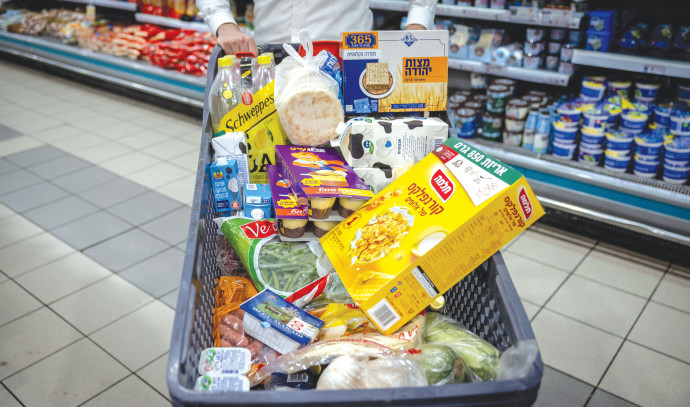|
Getting your Trinity Audio player ready...
|
Newly released OECD data unveiled on Sunday revealed that Israel boasted the highest cost of living in 2022 compared to all other OECD nations, surpassing the average by a substantial 38%. Not far behind is Switzerland, which had, until recently, held the leading rank on this index.
While the knee-jerk response to this data may be to prophesize doom for the Israeli economy, doing so would be falling victim to sensationalism, claims Prof. Dan Ben-David, head of the Shoresh Institution for Socioeconomic Research and an economist at Tel-Aviv University.
According to him, the comparison between prices in Israel last year and the OECD average is misleading. “On the one hand, the gap between Israel and the OECD has increased for over a decade. On the other hand, inflation in Israel has been lower than in most OECD countries – so how could the gap be growing? The reason is that over this period, the shekel became increasingly stronger, so any price denoted in shekels became – by definition – more expensive in dollars and euros,” he explained.
He noted that these factors should not be taken as a sign that prices in Israel are particularly low — they’re definitely not — but merely pointing at the headlining numbers without looking more closely is likely to lead to sensationalism.
Furthermore, observers should guard themselves against naive assumptions when next year’s numbers are released, even though they’ll probably look much better than this year’s.
How will a weaker shekel look better on paper?
Ben-David explained that, while the shekel’s devaluation — which he attributes to the current government — has contributed to Israeli inflation, “It will be more than offset in next year’s comparisons, when Israeli prices will be converted into dollars and euros.”
To elaborate: in the context of comparing prices, when the shekel is devalued, it takes more shekels to represent the same value in dollars or euros. This means that when you convert prices from shekels to dollars or euros, they will appear lower. For instance, if a product costs 100 shekels before the shekel devaluation, it might have cost the equivalent of 25 dollars. But after the devaluation, that same product might still cost 100 shekels, which might now be worth only 20 dollars due to the weaker shekel.
So, when prices are denoted in shekels, a devaluation of the shekel makes those prices appear lower in international currencies like dollars or euros. Therefore, said Ben-David, next year’s likely reduction in the gap between Israeli and OECD average prices “Will not be the result of something good that the government did but actually a result of the mayhem that they are causing.”
The actual problem we need to measure
The real issue lies in assessing how many consumption baskets a median Israeli income can buy versus the median income in OECD countries. “In nearly every case (except communications) the median Israeli income buys less – often considerably less – than the median income in the OECD countries. The question is whether this is due to the high Israeli prices, or to the low Israeli incomes,” he elaborated.
He concluded that the root of our high prices and low incomes originates from long-standing negligence of vital infrastructure, both in human capital (e.g. education) and physical capital (e.g. transportation) sectors. These, “Alongside an over-bearing, extremely inefficient, bureaucracy… combine to create a substantial weight on our productivity, which in turn lowers our income and raises our prices.”
The key takeaway is that next year will likely see better numbers in the cost of living comparison — but because those better numbers will come as a result of the shekel’s excessive devaluation, key measurements such as Israelis’ ability to purchase consumer baskets (without bringing currency conversion into the picture to muddle up numbers), as well as the country’s progress in combatting both inflation and currency devaluation, will be much more critical measures to observe.
Mounting pressure
A State Comptroller report released in May delved into the escalating cost of living in Israel and its impact on crucial sectors like the dairy industry and real estate market. The dairy industry, representing a staple of the Israeli diet, has faced significant price increases, with the comptroller’s audit revealing that raw milk costs around 24% more in Israel compared to the European Union average. The gap between consumer milk prices in Israel and the OECD average is a staggering 77%.
The comptroller report also underlined the dire state of housing in Israel. Over the past decade, housing prices surged by an alarming 208%, primarily due to a severe housing unit shortage. A cumulative shortfall of around 189,000 housing units from 2006 to 2022 has led to an imbalanced supply-demand equation. Although the Israel Land Authority (ILA) was established to address this shortage, the report criticized its ineffectiveness in fulfilling its responsibilities.
The comptroller report further scrutinized Israel’s strategies for residential land planning and marketing, exposing inconsistencies and shortcomings. The strategic plan, aimed at creating 2.6 million housing units by 2040, hasn’t been fully realized. The Planning Administration’s irregular reporting, lack of discussion by the Israel Lands Council, and various barriers during residential plan approval stages further complicate the situation.
To rectify these issues, the State Comptroller recommended the Planning Administration shorten timeframes for promoting detailed plans, submit annual reports to the housing cabinet, and urged the Construction and Housing Minister to formulate an action plan for strategic land planning.



